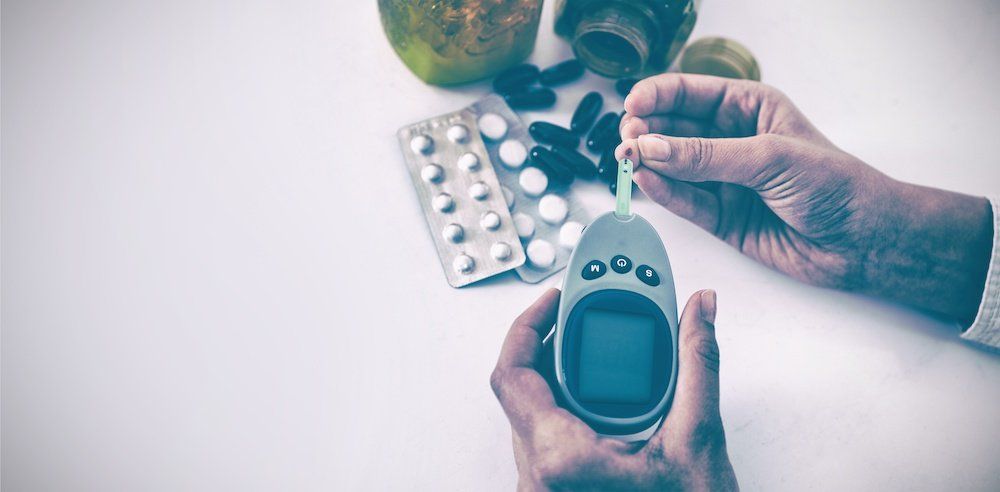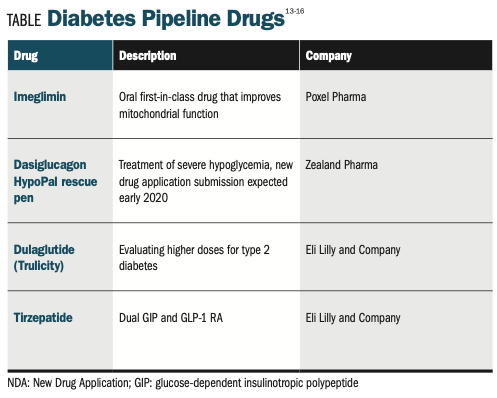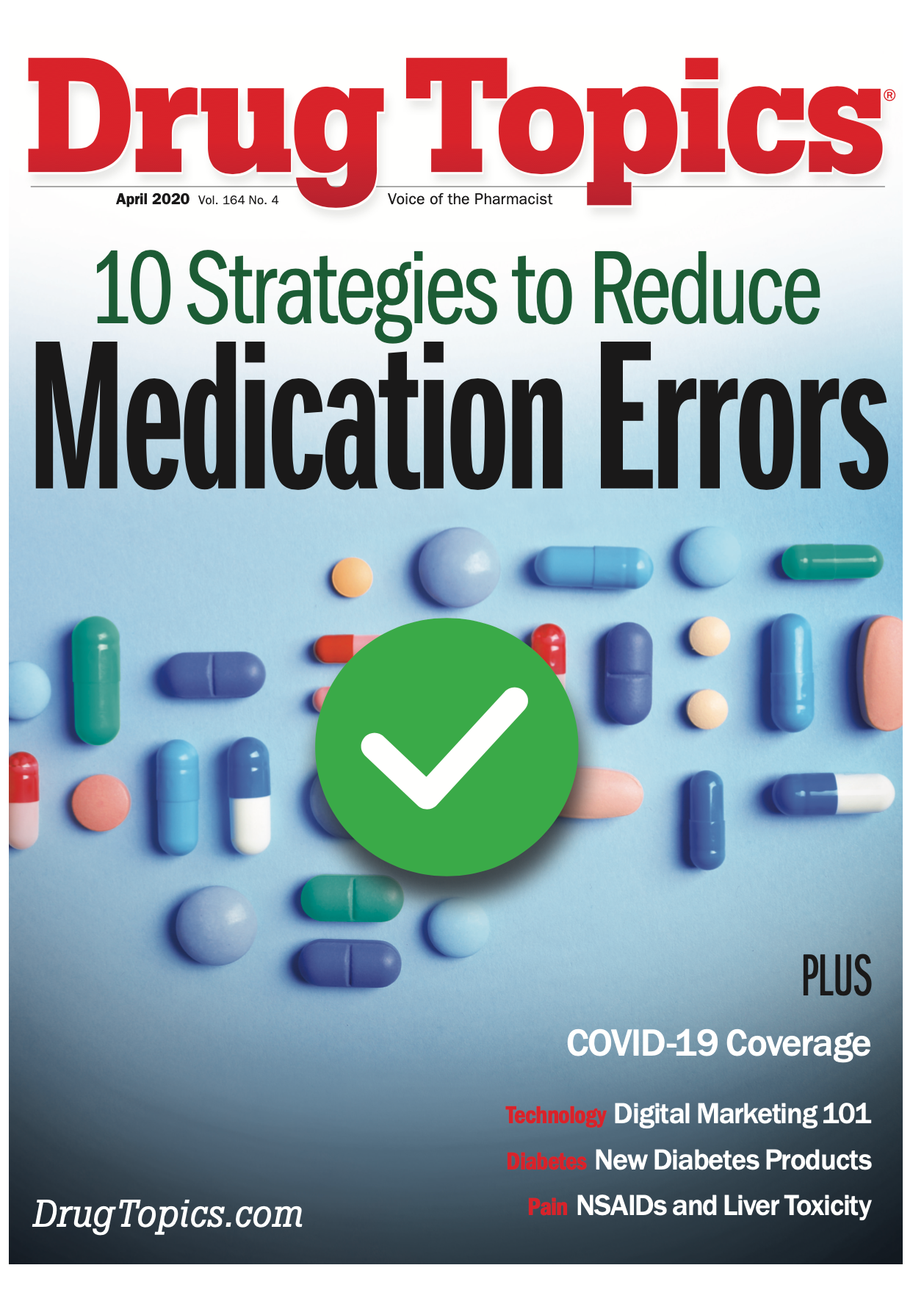New Diabetes Medications, Technologies You Should Know
Pharmacists can play an integral role in managing patients with diabetes.

Diabetes Pipeline Drugs

According to the National Diabetes Statistics Report, 34.2 million Americans are living with diabetes. With new drugs and technologies available, pharmacists are at the forefront of the effort to educate patients and health care professionals about diabetes treatments, monitoring options, and pipeline drugs (see Table). Pharmacists can assist with individualizing technology based on patients’ needs.
New Diabetes Medications
Semaglutide
Semaglutide (Rybelsus) was approved on September 20, 2019, as the first oral medication in the drug class glucagon-like peptide receptor agonist (GLP-1 RA), which is unique in its format-the other drugs in the class are injections.2,3 It is indicated for the treatment of type 2 diabetes, in combination with diet and exercise.4 Semaglutide injectable (Ozempic) was approved in 2017 for patients with type 2 diabetes.2 Rybelsus is not recommended as first-line therapy for patients with type 2 diabetes; rather, metformin is considered the preferred drug for initial treatment.2 Novo Nordisk, the manufacturer of Rybelsus, provides a savings support card to eligible patients with private or commercial insurance; individuals can use the card to pay $10 for a 30-day prescription of the medication.5 The American Diabetes Association (ADA) guidelines recommend the use of a GLP-1 RA, such as semaglutide, to achieve greater blood glucose lowering over initiating insulin for patients whose oral therapy treatments have failed.6
“Pharmacists should counsel patients to take Rybelsus at least 30 minutes before the first food, beverage, or other oral medication for the day, with no more than 4 ounces of plain water. This counseling point is imperative to ensure that patients get the most benefit they can from this medication,” said Andrea Levin, PharmD, BCACP, assistant professor, Department of Pharmacy Practice, Nova Southeastern University College of Pharmacy. The most common adverse effects (AEs) include nausea, diarrhea, vomiting, decreased appetite, indigestion, and constipation.4 Rybelsus carries a boxed warning regarding the increased risk of thyroid c-cell tumors, and patients who have had medullary thyroid carcinoma (MTC) or a family history of MTC should not take the medication.4
The starting dose of Rybelsus is 3 mg orally once daily for 30 days. After 30 days, the dose should be increased to 7 mg once daily, which may be increased to a maximum of 14 mg once daily if additional blood glucose lowering is needed after at least 30 days on the 7-mg dose.4 The PIONEER 3 randomized clinical trial evaluated the safety and efficacy of oral semaglutide with a dose of 7 mg/day and 14 mg/day, compared with sitagliptin added on to metformin with or without a sulfonylurea, in patients with type 2 diabetes.7 There were 1864 patients included in the study conducted at 206 sites in 14 countries. The study revealed that both doses of semaglutide compared with sitagliptin resulted in statistically significant greater reductions in A1C levels over 26 weeks (P < 0.001).7
Glucagon
Glucagon (Baqsimi) nasal powder was approved July 24, 2019 as the first glucagon therapy for the emergency treatment of severe hypoglycemia that can be administered without an injection.8 The glucagon injection must be mixed through a several step process. Glucagon nasal powder is approved for patients 4 years and older, and the product comes ready to use in a precise premeasured dose. Eli Lilly also provides a coupon for patients with commercial drug coverage to pay $25 for up to 2 devices. The recommended dose is 3 mg administered as 1 actuation of the intranasal device into 1 nostril. If there is no response after 15 minutes, an additional 3 mg dose from a new device may be administered while waiting for emergency assistance. The most common AEs associated with glucagon nasal powder are nausea, vomiting, headache, upper respiratory tract irritation, watery eyes, eye redness, and itching of the throat.8
Pharmacists can play an important role in counseling patients about the appropriate use of glucagon nasal powder. Patients should be educated to ensure that caregivers, family, and friends know where the product is kept and how to use it. The shrink-wrap or tube should not be opened until it is ready to be used or the product may not be fully effective.8 To prepare the dose, the shrink-wrap should be removed by pulling on the red stripe, and the lid can be opened and the device should be removed from the tube. The plunger should not be pressed until the dose is ready to be given. The device should be held between the fingers and thumb, and the tip should be inserted gently into 1 nostril until finger(s) touch the outside of the nose. Then, the plunger should be pushed firmly all the way in. The dose is complete when the green line disappears. After administering the dose, someone should call 911 emergency services immediately, and the device and tube should be discarded. The patient should be encouraged to have a fast-acting source of sugar (eg juice) and a snack as soon as possible. If the patient is unconscious, then the individual should be turned onto his or her side. Glucagon nasal powder should be stored in the shrink-wrapped tube at temperatures up to 86° F.8 Patients should replace the used product right away so it is readily available.
Liraglutide
Victoza (liraglutide) was approved June 17, 2019, for pediatric patients 10 years of age and older for the treatment of type 2 diabetes.9 This is the first non-insulin drug approved to treat type 2 diabetes in children since metformin was approved for pediatric patients in 2000.9 The starting dose of liraglutide for pediatric patients is 0.6 mg daily, and after at least 1 week, it may be increased to 1.2 mg daily if additional blood glucose lowering is needed.10 The maximum dose is 1.8 mg daily after at least 1 week of treatment with 1.2 mg daily. Liraglutide includes a boxed warning about the increased risk of thyroid C-cell tumors. Patients who have a medical or family history of MTC, or an endocrine system condition called multiple endocrine neoplasia syndrome type 2, should not use liraglutide. The most common AEs are nausea, diarrhea, vomiting, decreased appetite, indigestion, and constipation.10
Innovative Technologies
Diabetes technology includes hardware, devices, and software that patients can use to help manage their condition.11 Levin discussed some of the advances in diabetes technology, such as continuous glucose monitoring (CGM), and emphasized that insurance coverage varies by plan. The 2020 ADA guidelines provide more evidence-based information about available technologies and emphasize an individualized approach to selecting the best one, depending on the patient’s needs.11
“One of the great benefits of CGM is that patients are alerted when blood glucose levels are low or high,” said Levin. Additionally, CGM is a useful tool for lowering A1C levels. Most patients using intensive insulin regimens (multiple daily injections or insulin pump therapy) should assess blood glucose levels using self-monitoring of blood glucose or CGM prior to meals and snacks, at bedtime, prior to exercise, when blood glucose is expected to be low, after treating low blood glucose until it is normal, and prior to and while performing critical tasks, such as driving.11 DiabetesWise. org is a nonprofit resource that pharmacists and patients can use to help decide on the best device.12 The CGM options include Dexcom G6, Medtronic Guardian, Abbott Freestyle Libre, and Eversense.12
References:
1. CDC. National Diabetes Statistics Report, 2020. CDC website. https://www.cdc.gov/diabetes/library/features/diabetes-stat-report.html. Accessed February 25, 2020.
2. FDA. New Drug Therapy Approvals 2019. FDA website. https://www.fda.gov/drugs/new-drugs-fda-cders-new-molecular-entities-and-new-therapeutic-biological-products/new-drug-therapy-approvals-2019. Published January 6, 2020. Accessed February 27, 2020.
3. FDA Approves First Oral GLP-1 Treatment for Type 2 Diabetes [news release]. Silver Spring, MD; September 20, 2019: FDA website. https://www.fda.gov/news-events/press-announcements/fda-approves-first-oral-glp-1-treatment-type-2-diabetes. Accessed February 28, 2020.
4. Rybelsus [prescribing information]. Plainsboro, NJ: Novo Nordisk Inc; 2020. https://www.novo-pi.com/rybelsus.pdf. Accessed February 28, 2020.
5. NovoCare. Rybelsus. NovoCare website. https://www.novocare.com/rybelsus/savings-card.html. Accessed February 28, 2020.
6. American Diabetes Association. 9. Pharmacologic approaches to glycemic treatment: Standards of Medical Care in Diabetes-2020. Diabetes Care. 2020;43(Suppl 1):S98-S110. doi: 10.2337/dc20-S009.
7. Rosenstock J, Allison D, Birkenfeld AL, et al. Effect of additional oral semaglutide vs sitagliptin on glycated hemoglobin in adults with type 2 diabetes uncontrolled with metformin alone or with sulfonylurea: the PIONEER 3 randomized clinical trial. JAMA. 2019; ;321(15):1466-1480. doi: 10.1001/jama.2019.2942.
8. Baqsimi [prescribing information]. Indianapolis, IN: Eli Lilly and Company; 2019. http://uspl.lilly.com/baqsimi/baqsimi.html#pi. Accessed February 29, 2020.
9. FDA Approves New Treatment for Pediatric Patients with Type 2 Diabetes [news release]. Silver Spring, MD; June 17, 2019: FDA website. https://www.fda.gov/news-events/press-announcements/fda-approves-new-treatment-pediatric-patients-type-2-diabetes. Accessed February 29, 2020.
10. Victoza [prescribing information]. Plainsboro, NJ: Novo Nordisk Inc; 2019. https://www.novo-pi.com/victoza.pdf. Accessed February 29, 2020.
11. American Diabetes Association. 7. Diabetes Technology: Standards of Medical Care in Diabetes-2020. Diabetes Care. 2020; 43(Suppl 1):S77-S88. doi: 10.2337/dc20-S007.
12. DiabetesWise.org. How to get a sensor. DiabetesWise.org website. https://diabeteswise.org/how-to-get-a-sensor. Accessed February 29, 2020.
13. Poxel. Imeglimin. Poxel website. https://www.poxelpharma.com/en_us/product-pipeline/imeglimin-us-eu. Accessed February 29, 2020.
14. Zealand Pharma. Dasiglucagon in a ready-to-use rescue pen. Zealand Pharma website. https://www.zealandpharma.com/dasiglucagon-rescue. Accessed February 29, 2020.
15. Eli Lilly and Company. Lilly’s AWARD-11 trial studying higher investigational doses of Trulicity (dulaglutide) demonstrated superiority in A1C reduction in people with type 2 diabetes. Eli Lilly website. https://investor.lilly.com/news-releases/news-release-details/lillys-award-11-trial-studying-higher-investigational-doses. Accessed February 29, 2020.
16. ClinicalTrials.gov. A study of tirzepatide (LY3298176) compared with dulaglutide on major cardiovascular events in participants with type 2 diabetes (SURPASS-CVOT). ClinicalTrials.gov website. https://clinicaltrials.gov/ct2/show/NCT04255433. Accessed February 29, 2020.
